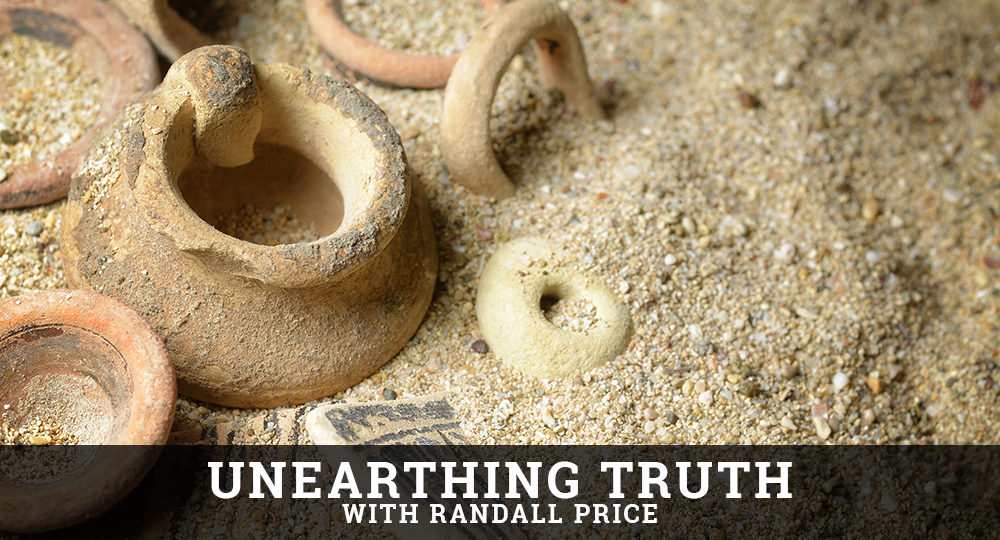The Big Ten
An Archaeological Look at the Ten Commandments
Many people are familiar with Cecil B. DeMille’s film The Ten Commandments. In a famous scene, Moses receives the Ten Commandments on stone tablets carved by the finger of God (cf. Ex. 31:18). He then takes a long trek down Mt. Sinai, ultimately hoisting the huge tablets above his head and smashing them against the idolatrous golden calf built by the rebellious Israelites (cf. 32:15–19). To the critical eye, the scene lacks reality because Moses carries tablets that appear to weigh more than 50 pounds each. Quite a feat for an octogenarian!
Archaeology and the Bible confirm a more realistic picture. The Bible explicitly says, “Moses turned and went down from the mountain, and the two tablets of the Testimony were in his hand” (v. 15, emphasis added). The Hebrew text reads beyado (singular, “his hand”) and not beyadav (plural, “his hands”).1 The language implies Moses could carry both tablets in one hand.
Based on discoveries of inscribed stone tablets from the ancient Near East containing legal covenants, the Ten Commandments probably were carved on stone flakes not much larger than the size of a man’s hand.2
The Hebrew for Ten Commandments, aseret haddevarim, literally means “the ten words.” Therefore, the Ten Commandments also are called the Decalogue, from the Greek words deca (ten) and logos (word). God may have provided ten simply because people have ten fingers, and this number was sufficient to summarize the principal points of the Law for memorization.
All traditions agree on this number, but there are three divisions of the material in Orthodox Judaism, Eastern Orthodoxy, Roman Catholicism, and Protestant denominations.3 Archaeology demonstrates from the form of ancient law codes that Exodus 20:2 is better taken as a historical prologue, rather than as a commandment, as found in Orthodox Judaism.4
Some scholars believe the same text appeared on both tablets and that one copy was for the people and the other for God (the two parties making the agreement). However, in ancient Near Eastern cultures in Moses’ day, the custom was for people to place legal documents and agreements between rival kingdoms at the feet of their god in their sanctuary. The “god” then acted as the guardian of treaties and supervised their implementation.5
Since the Ten Commandments appear to follow the Suzerainty-Vassal Treaty form, the pair of tablets kept in the Ark of the Covenant probably was viewed as God’s copy. Therefore, the commandments would have been distributed between both tablets. Although not stated, it would seem that accessible copies (perhaps on clay) were made for the Israelites and their leaders (cf. Dt. 27:3; Josh. 8:32).
The fact that Israel adopted practices similar to pagan cultures does not detract from the uniqueness of God’s special revelation to them as His Chosen People. God accommodated local customs, yet with a distinct theological meaning that magnified His unique relationship with Israel by contrast.
These archaeological details concerning the Ten Commandments are important for answering questions not provided in the biblical text. They provide a fuller picture of the biblical event. Still, it is more important that we know the Ten Commandments than simply know about them.
A man once told his pastor he had recently returned from a tour to Mt. Sinai where, at the top of the mountain, he had read the Ten Commandments. He asked his pastor, “What could be better than that?”
The pastor replied, “To have stayed home and done them!” May we all find that better experience as we know and do these commandments.
ENDNOTES
-
-
- In Exodus 17:12, the plural is used twice of Moses’ “hands” (Hebrew, yadav).
- See Alan R. Millard, “Recreating the Tablets of the Law,” Bible Review 10:1 (February 1994): 49–53.
- Orthodox Judaism includes “I am the LORD your God” (Ex. 20:2) as part of the first commandment, whereas the others start the first commandment with verse 3: “You shall have no other gods before Me”; and some transpose the order of various commandments.
- See David L. Baker, “Ten Commandments, Two Tablets: The Shape of the Decalogue,” Themelios (Summer 2005): 6–9.
- Egyptian records provide an example of this fact in a pact between Ramesses II and Hattusilis III in which their concord is sealed by depositing a treaty at the feet of both the Hittite king’s god Teshup and the Pharaoh’s god Ra.
-




